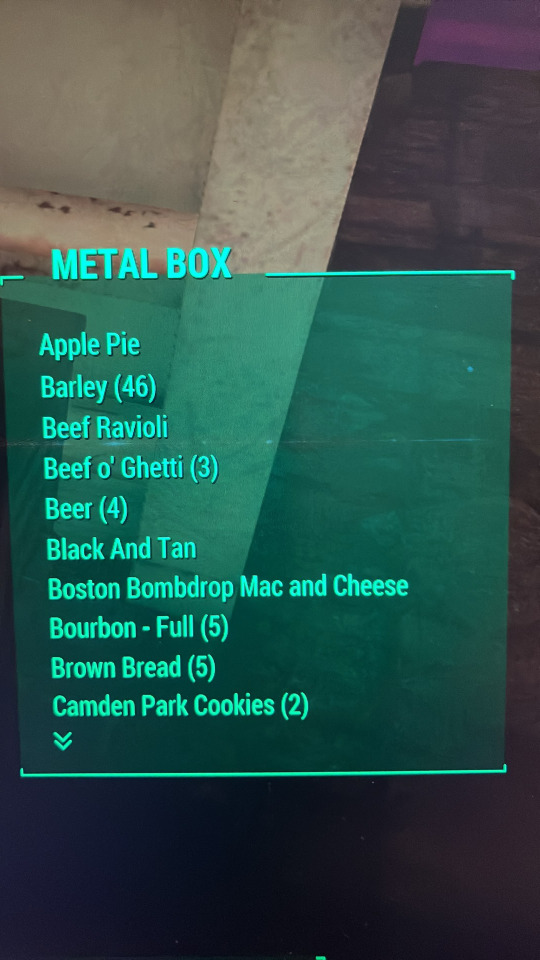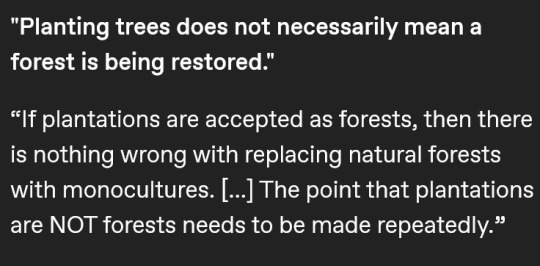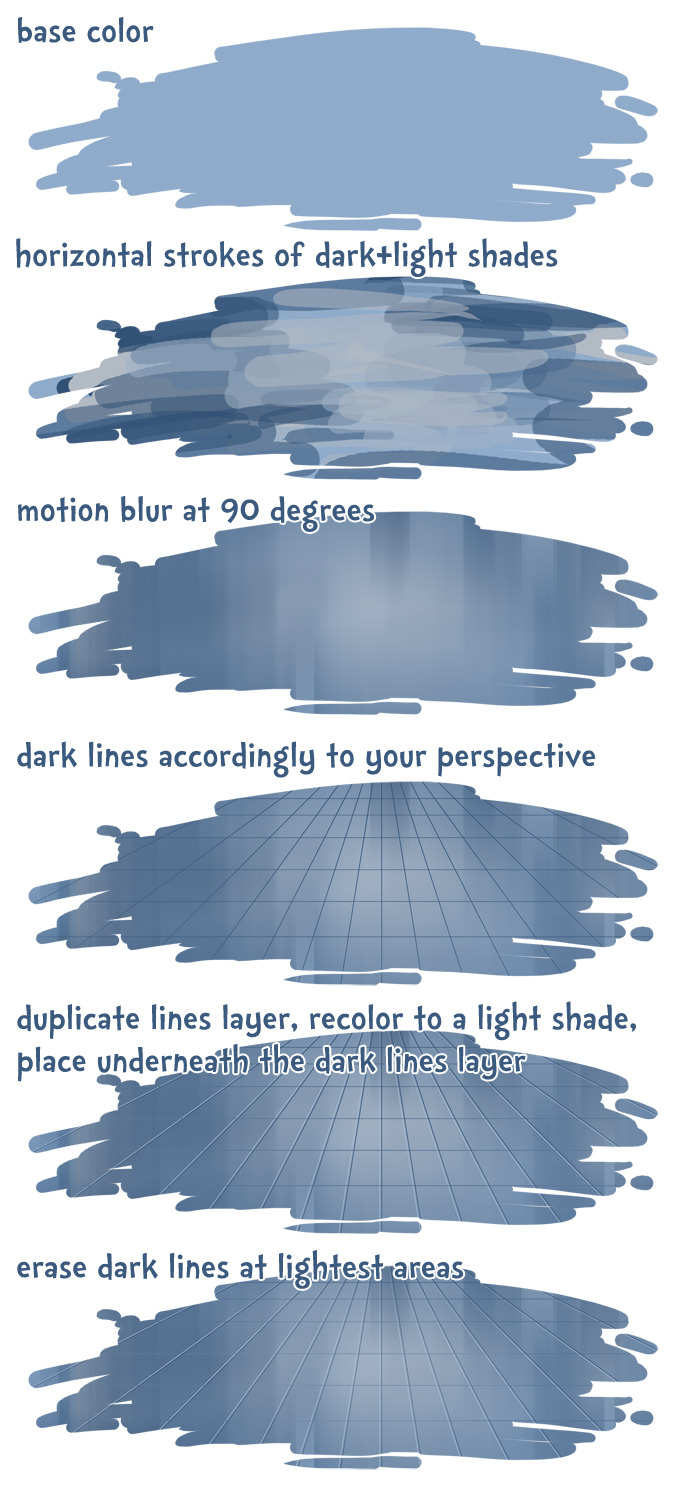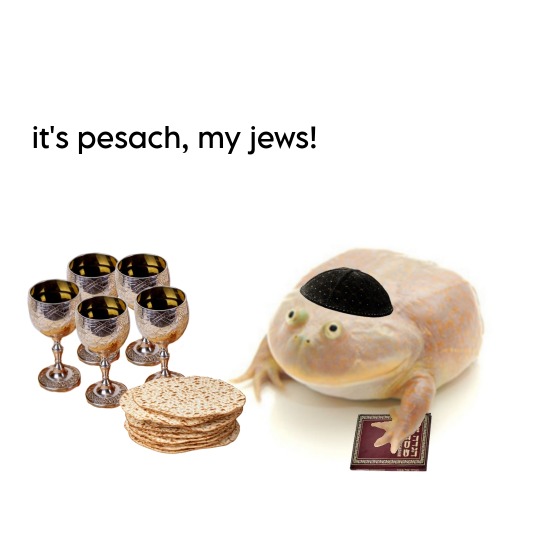Text
Thanks to the power of mods, A Wasteland Seder:

Seder plate (CREAtive Clutter)
Wine (vanilla)
Roasted carrots (C.H.E.F.)
Fresh Jonnycakes (Mutant Menagerie)
Mutfruit Jam (Mutant Menagerie)
Haggadah (Overdue book, vanilla)
Cooked poultry (Mutant Menagerie)
Vegetable soup (vanilla)
The jonnycakes are corn and are substituted for matzo because I have no recipes for matzo (they’re unleavened and they’re basically bread GOOD ENOUGH), and the jam is to spread on them for dessert.

Pesach in the Wasteland.
(Yes, I’m putting away my Fallout chametz. I should have done it a few days ago but forgot. At least I haven’t gotten any caps off it, so…)
14 notes
·
View notes
Text
Actually, on that note, can I harvest my razorgrain for the next eight days? Or do I have to get rid of everything that appears in the workshop?

Pesach in the Wasteland.
(Yes, I’m putting away my Fallout chametz. I should have done it a few days ago but forgot. At least I haven’t gotten any caps off it, so…)
14 notes
·
View notes
Text

Pesach in the Wasteland.
(Yes, I’m putting away my Fallout chametz. I should have done it a few days ago but forgot. At least I haven’t gotten any caps off it, so…)
14 notes
·
View notes
Text

Despite its green image, Ireland has surprisingly little forest. [...] [M]ore than 80% of the island of Ireland was [once] covered in trees. [...] [O]f that 11% of the Republic of Ireland that is [now] forested, the vast majority (9% of the country) is planted with [non-native] spruces like the Sitka spruce [in commercial plantations], a fast growing conifer originally from Alaska which can be harvested after just 15 years. Just 2% of Ireland is covered with native broadleaf trees.
Text by: Martha O’Hagan Luff. “Ireland has lost almost all of its native forests - here’s how to bring them back.” The Conversation. 24 February 2023. [Emphasis added.]
---
[I]ndustrial [...] oil palm plantations [...] have proliferated in tropical regions in many parts of the world, often built at the expense of mangrove and humid forest lands, with the aim to transform them from 'worthless swamp' to agro-industrial complexes [...]. Another clear case [...] comes from the southernmost area in the Colombian Pacific [...]. Here, since the early 1980s, the forest has been destroyed and communities displaced to give way to oil palm plantations. Inexistent in the 1970s, by the mid-1990s they had expanded to over 30,000 hectares. The monotony of the plantation - row after row of palm as far as you can see, a green desert of sorts - replaced the diverse, heterogenous and entangled world of forest and communities.
Text by: Arturo Escobar. "Thinking-Feeling with the Earth: Territorial Struggles and the Ontological Dimension of the Epistemologies of the South." Revista de Antropologia Iberoamericana Volume 11 Issue 1. 2016. [Emphasis added.]
---
But efforts to increase global tree cover to limit climate change have skewed towards erecting plantations of fast-growing trees [...] [because] planting trees can demonstrate results a lot quicker than natural forest restoration. [...] [But] ill-advised tree planting can unleash invasive species [...]. [In India] [t]o maximize how much timber these forests yielded, British foresters planted pines from Europe and North America in extensive plantations in the Himalayan region [...] and introduced acacia trees from Australia [...]. One of these species, wattle (Acacia mearnsii) [...] was planted in [...] the Western Ghats. This area is what scientists all a biodiversity hotspot – a globally rare ecosystem replete with species. Wattle has since become invasive and taken over much of the region’s mountainous grasslands. Similarly, pine has spread over much of the Himalayas and displaced native oak trees while teak has replaced sal, a native hardwood, in central India. Both oak and sal are valued for [...] fertiliser, medicine and oil. Their loss [...] impoverished many [local and Indigenous people]. [...]
India’s national forest policy [...] aims for trees on 33% of the country’s area. Schemes under this policy include plantations consisting of a single species such as eucalyptus or bamboo which grow fast and can increase tree cover quickly, demonstrating success according to this dubious measure. Sometimes these trees are planted in grasslands and other ecosystems where tree cover is naturally low. [...] The success of forest restoration efforts cannot be measured by tree cover alone. The Indian government’s definition of “forest” still encompasses plantations of a single tree species, orchards and even bamboo, which actually belongs to the grass family. This means that biennial forest surveys cannot quantify how much natural forest has been restored, or convey the consequences of displacing native trees with competitive plantation species or identify if these exotic trees have invaded natural grasslands which have then been falsely recorded as restored forests. [...] Planting trees does not necessarily mean a forest is being restored. And reviving ecosystems in which trees are scarce is important too.
Text by: Dhanapal Govindarajulu. "India was a tree planting laboratory for 200 years - here are the results." The Conversation. 10 August 2023. [Emphasis added.]
---
Nations and companies are competing to appropriate the last piece of available “untapped” forest that can provide the most amount of “environmental services.” [...] When British Empire forestry was first established as a disciplinary practice in India, [...] it proscribed private interests and initiated a new system of forest management based on a logic of utilitarian [extraction] [...]. Rather than the actual survival of plants or animals, the goal of this forestry was focused on preventing the exhaustion of resource extraction. [...]
Text by: Daniel Fernandez and Alon Schwabe. "The Offsetted." e-flux Architecture (Positions). November 2013. [Emphasis added.]
---
At first glance, the statistics tell a hopeful story: Chile’s forests are expanding. […] On the ground, however, a different scene plays out: monocultures have replaced diverse natural forests [...]. At the crux of these [...] narratives is the definition of a single word: “forest.” [...] Pinochet’s wave of [...] [laws] included Forest Ordinance 701, passed in 1974, which subsidized the expansion of tree plantations [...] and gave the National Forestry Corporation control of Mapuche lands. This law set in motion an enormous expansion in fiber-farms, which are vast expanses of monoculture plantations Pinus radiata and Eucalyptus species grown for paper manufacturing and timber. [T]hese new plantations replaced native forests […]. According to a recent study in Landscape and Urban Planning, timber plantations expanded by a factor of ten from 1975 to 2007, and now occupy 43 percent of the South-central Chilean landscape. [...] While the confusion surrounding the definition of “forest” may appear to be an issue of semantics, Dr. Francis Putz [...] warns otherwise in a recent review published in Biotropica. […] Monoculture plantations are optimized for a single product, whereas native forests offer [...] water regulation, hosting biodiversity, and building soil fertility. [...][A]ccording to Putz, the distinction between plantations and native forests needs to be made clear. “[...] [A]nd the point that plantations are NOT forests needs to be made repeatedly [...]."
Text by: Julian Moll-Rocek. “When forests aren’t really forests: the high cost of Chile’s tree plantations.” Mongabay. 18 August 2014. [Emphasis added.]
2K notes
·
View notes
Photo

not to be a nerd but it’s so crazy how he (Bernini) really did that from cold hard stone……. truly a spectacle, truly breathtaking, an honor to behold
467K notes
·
View notes
Text
The Places Fandom Dwells: A Cautionary Tale
Just about seven years ago, on 29 May 2007, hundreds of fans with accounts at Livejournal woke uo make the shocking discovery that their blogs, and those of some of their friends and favorite fandom communities, had been deleted without prior notice.
It’s estimated that Livejournal suspended approximately 500 blog accounts. The only notice of this was was the strike through the names of the suspended blogs, which led to this event being called Strikethrough.
At the time, Livejournal was the primary blogging platform for fandom. Its friends list and threaded conversations enabled fans to find each other and have discussions. Its privacy settings allowed fans to share as much or as little as they chose. It was a place to publish and archive fan fic, art, and meta. These features give some idea why the deletions of so many fandom blogs had been so devastating.
Speculation and uncertainty were rampant during the two days it took for Livejournal to finally respond to demands from users for information. At first, LJ stated only that it had been advised that journals listing an illegal activity as an interest could be regarded as soliciting for that illegal activity, which put the site at legal risk. It was eventually revealed that Livejournal and its owners at the time, Six Apart, had been contacted by a group calling themselves Warriors for Innocence, a conservative Christian organization with ties to the militia movement who accused LJ of being a haven for pedophiles and child pornography.
LJ had based the account suspensions on the tags used in LJ blogs. LJ users list their interests in their profiles, and those interests functions as tags. LJ took the blanket view that there was no difference between blogs listing “rape”.”incest”, or “pedophilia” among their interests, and blogs with posts tagged “rape”. “incest”, or “pedophilia”. As a consequence, some of the accounts that were suspended were support sites for rape survivors and gay teens, as well as the fandom sites that posted book discussions, RP, fan fiction, and fan art.
Livejournal grudgingly issued a partial apology to users on 31 May, but it took months for the organization to sort through the suspended blogs. According to Livejournal, most of the suspended accounts were restored. Not all of the suspended accounts were restored, and some of those that weren’t belonged to the support groups and fandoms.
One result of Strikethrough was that many communities and individual fans locked their blogs so the content could be viewed only community members, or those on their friends lists. Other fans opened accounts at blogging platforms like JournalFen, The Greatest Journal, or Insane Journal. There was definitely an atmosphere of mistrust and paranoia that hadn’t previously existed, and part of the problem was that Livejournal had not come through with promised clarification about what sort of content violated the ToS.
So, of course, it happened all over again.
On 3 August, Livejournal once again suspended a number of accounts without warning. This time, the account names were bolded, and the event became known as Boldthrough.
These deletions were the result of decisions made by a group consisting of members of LiveJournal’s Abuse Prevention Team, made up of LiveJournal employees and Six Apart staff, that had been set up to review blog content. This group was had been empowered to declare blog content offensive, a violation of the ToS that was defined by the team as content not containing enough serious artistic value to offset the sexual nature of the material. The team was empowered to terminate accounts without warning.
Anxious and angry LJ users waited ten days until LJ issued a response. Eventually, the ToS was changed to state that accounts deemed in violation of the ToS would in future be deleted only if the offender refused to delete offending content.
Just a few days before Strikethrough, LJ user astolat proposed a new blogging platform and fan fic archive, one that would be be created by fans, for fans. This was the birth of the Organization for Transformative Works, a non-profit organization dedicated to provide access to fanworks, and to protect and defend fanworks from commercial exploitation and legal challenge. Strikethrough and Boldthrough definitely pushed the project along. OTW opened DreamWidth in beta mode in April 2009, and began open beta testing of Archive of Our Own in November 2009.
In mid-January 2010, DreamWidth came under pressure by an undisclosed group who tried to convince DW’s server and PayPal, among others, that DW was a platform for child pornography. DW refused to give in to the harassment and intimidation, and promptly notifed users about the situation. The only consequence of the group’s pressure was that new requests for paid services were temporarily put on hold until DW was able to find a new payment processor service. DW remained true to its Guiding Principles by keeping users informed throughout this incident, and respecting freedom of expression by refusing to delete any posts or blogs to satisfy the demands of the group of trolls.
Which brings us to Tumblr.
Tumblr was launched in 2007. While not all fans have embraced it, citing reasons like character restrictions in replies and asks and the difficulty of finding others who share one’s fandom, it’s certain that the majority of fandoms are well-represented.
However, in July 2013, fans once again expressed outrage when Tumblr - without warning – removed accounts flagged as “NSFW” or “Adult” from public searches, made those blogs inaccessible to Tumblr users not already following them, and deleted a number of tags from its mobile app, including #gay, #lesbian and #bisexual. In a manner unsettlingly reminiscent of Strikethrough and Boldthrough, Tumblr did not immediately respond, and the response posted 24 hours later was widely regarded as a non-apology apology. Tumblr claimed it had been trying to get rid of commercial porn blogs, and eventually asserted that all the removed accounts had been reinstated.
If there’s a lesson to be learned from this, it’s that which George Santayana proclaimed: Those who cannot remember the past are condemned to repeat it. Most blogging and social networking sites are in business to make a profit, and fandoms make them uncomfortable. They inevitably take steps to control the content being posted, to keep outside groups or their new owners happy, disrupting fandoms and deleting material that fans had considered to be safely stored.
The only solution I can see is for fans to copy and back up the things that are important. Maintain active accounts at several sites. Keep a list of your friends’ pseudonyms and emails.
Because the only thing that’s certain is that it’s going to happen again, when we least expect it.
I highly recommed that you read A brief history of fandom, for the teenagers on here who somehow think tumblr invented fandom: by ofhouseadama.
This article is still being revised. I intend to eventually make proper footnotes at some point, but until then, here’s a list of sources I used in writing this article:
http://astolat.livejournal.com/150556.html
http://astridv.livejournal.com/84769.html
http://boingboing.net/2007/05/31/lj-purge-drama-who-a.html
http://www.dailydot.com/culture/livejournal-decline-timeline/
http://www.dailydot.com/lifestyle/tumblr-nsfw-content-tags-search/
http://www.dailydot.com/opinion/tumblr-statement-banned-hashtags/
http://www.dailydot.com/society/pros-cons-tumblr-livejournal-fandom/
http://www.dailydot.com/society/tracking-livejournal-fandom-diaspora-infographic/
http://dw-news.dreamwidth.org/16590.html?view=top-only#comments
http://elke-tanzer.dreamwidth.org/951013.html
http://fanlore.org/wiki/Archive_Of_Our_Own
http://fandom-flies.livejournal.com/profile
http://fanlore.org/wiki/Boldthrough
http://fanlore.org/wiki/Dreamwidth
http://fanlore.org/wiki/LiveJournal
http://fanlore.org/wiki/Strikethrough
http://fanlore.org/wiki/Tumblr
http://fanthropology.livejournal.com/374988.html
http://hatteress.tumblr.com/post/55834911159/tumblrs-new-nsfw-restrictions-and-why-turning-off-safe
http://innocence-jihad.livejournal.com/159327.html
http://innocence-jihad.livejournal.com/31786.html
http://liz-marcs.livejournal.com/283323.html
http://liz-marcs.livejournal.com/283781.html
http://metafandom.livejournal.com/114942.html
http://www.metafilter.com/61636/livejournal-suspends-hundreds-of-accounts#1712054
http://missmediajunkie.blogspot.com/2013/05/why-i-dont-use-tumblr.html
http://news.cnet.com/Mass-deletion-sparks-LiveJournal-revolt/2100-1025_3-6187619.html
http://staff.tumblr.com/post/55906556378/all-weve-heard-from-a-bunch-of-you-who-are
http://www.supernaturalwiki.com/index.php?title=LJ_Strikethrough_2007#After_the_Strikethrough_-_On_to_Boldthrough
http://tech.firstpost.com/news-analysis/the-death-of-the-blog-and-the-rise-of-tumblr-210071.html
http://transformativeworks.org/sites/default/files/OTW_Annual_Report_2007.pdf
http://www.dailydot.com/business/yahoo-tumblr-fandom-lessons/
https://zine.openrightsgroup.org/features/2012/fandom:-open-culture-vs.-closed-platforms
http://www.zdnet.com/after-backlash-yahoos-tumblr-quietly-restores-adult-nsfw-blogs-7000018342/
16K notes
·
View notes
Text
the world would literally be a better place if cis people could just get trans surgeries "by mistake" rather than forcing trans people to jump through ten million hoops to get it.
22K notes
·
View notes
Text
They escape at the end by going down an alley too narrow for the car. If a running Action Dude(tm) can do it, no reason a wheelchair user can’t.
we need a fictional wheelchair user who does all the unrealistic bullshit cars and motorcycles do in fiction. i wanna see a wheelchair do the akira slide. i need a high speed chase with a nitro-fuelled wheelchair where the character out-maneuvers cop cars. does anyone understand me
51K notes
·
View notes
Text
Also hey, cultural history time: The reason why cats are associated with women wasn't ultimately and originally about women as sly, cruel, or capricious creatures, but about cats as mothers to their kittens. And yes, sure, reducing womanhood to motherhood and a woman's worth to her fertility is Much Bad, but nonetheless I want to stress that the reason cats became the symbol animal of so many goddesses and were associated with women from thereon wasn't over some "cats and women are sly and selfish, dogs and men are straightforward and loyal uwu" dichtonomy.
It was about cats' tendency to go "I am 4kg of whoop-ass and if you try to touch my eight beautiful children I will fucking kill you."
762 notes
·
View notes
Text
36K notes
·
View notes
Text
Frasurbane. It’s what I grew up with and at the time I thought it was very sophisticated. Now I think it’s got kind of a timeless look.
hipness purgatory
indie sleaze
global village coffeehouse
supergraphic ultramodern
memphis-milano
internet awesomesauce
pacific punk wave
utopian scholastic
frasurbane
curly girly
pastel southwestern
mission school
2K notes
·
View notes






